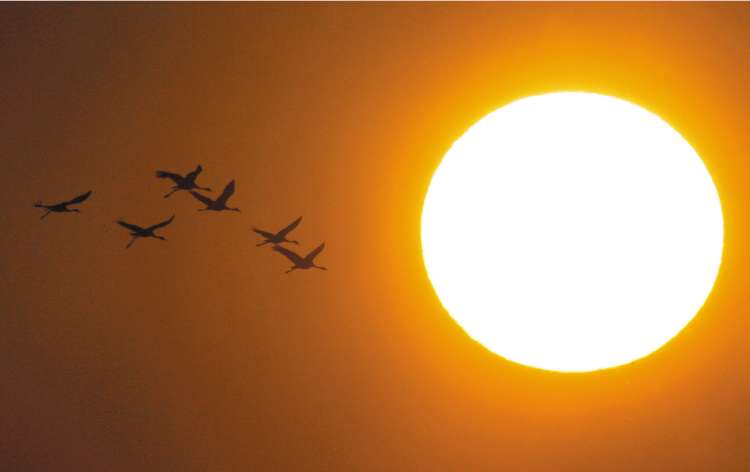Revealed: secret of how birds navigate during migration

The mystery of how migratory birds exploit the Earth's magnetic field using an internal compass may have been solved by scientists who have discovered how molecules in the eye can be orientated by weak magnetic lines.
About 50 species of animals are known to use the direction of Earth's magnetic field to help them find their way, but scientists have been mystified as to how they could do it because the field seems to be too weak to have an effect on the nervous system.
Now, though, scientists have come up with a possible method based on a series of complex photochemical reactions that can occur within the eyes of birds, as well as other animals, which could help them use an internal compass.
Professor Peter Hore, a physical chemist at Oxford University, explained: "Because the Earth's magnetic field is so weak, many people found it difficult to understand how it could affect bird or animal sense organs in a way that would help them to navigate.
"Our experiments with a model chemical system prove it is possible for molecules to detect weak fields and to respond to their directions. Birds may use similar chemical reactions in their retinas, where photochemical reactions could lead to nerve signals which help them to orientate."
Scientists have shown that animals can use a variety of cues to help them migrate long distances and return to the same breeding or feeding grounds. These include visual landmarks, the position of the Sun in the day or the stars at night, and even the smell of specific locations en route.
But over the past few decades, scientists have found that animals ranging from birds and mammals to sea turtles and even insects can use the Earth's magnetic field either as a compass to orientate themselves in a particular direction, or as a map to help them determine their location.
One suggestion is that animals do this by using an iron-containing molecule called magnetite which orientates according to the north-south direction of the Earth's magnetic field, in much the same way that a compass needle always points to magnetic north.
But Professor Hore and the co-leader of his Oxford research team, Christiane Timmel, have come up with another possible mechanism, which they explain in an experimental study published in the journal Nature.
Instead of magnetite, the scientists suggest that birds might be able to use photo-sensitive molecules which can be turned into one of two different chemical states depending on the direction of a magnetic field as weak as that of the Earth's.
The chemical the scientists used in their study is not the one that would be used by birds, but Professor Hore said that similar molecules with the same properties are known to exist in the retina of a bird's eye. "It's one source of orientation information they could use. It could not be used at night, but birds may use it at dusk to orientate themselves and set themselves up for night-time migration," he said.
"Over millions of years, birds and other animals have evolved exquisitely sensitive chemical compasses which we are only beginning to understand. Our work outlines the principles behind such a compass."
Amazing avian journeys
Northern wheatear Oenanthe oenanthe
From north-east Siberia to southern Africa, flying over the Himalayas.
Arctic Tern Sterna paradisaea
The only bird to be intimate with both Poles, flying over thousands of miles of ocean.
Amur falcon Falco amurensis
From China to southern Africa, flying over India and the Indian Ocean.
Short-tailed shearwater Puffinus tenuirostris
From Alaska to eastern Australia, covering much of the Pacific Ocean.
Swainson's hawk Buteo swainsoni
Travels from North to South America, flying over the Andes and the Amazon.
Join our commenting forum
Join thought-provoking conversations, follow other Independent readers and see their replies
Comments